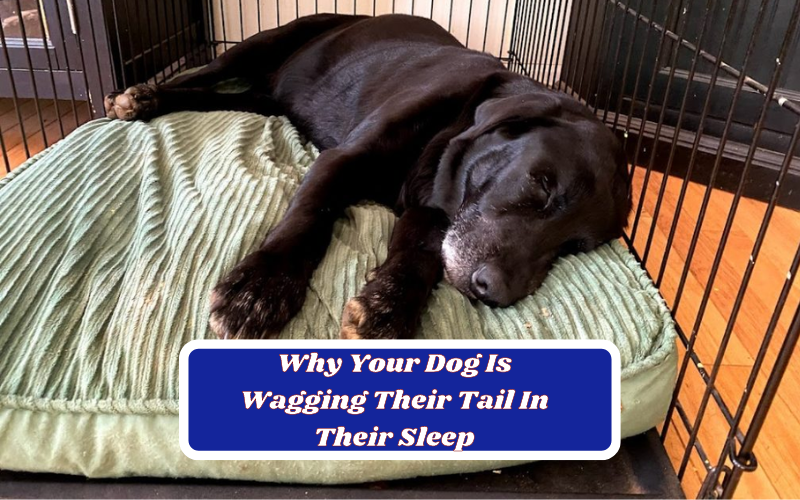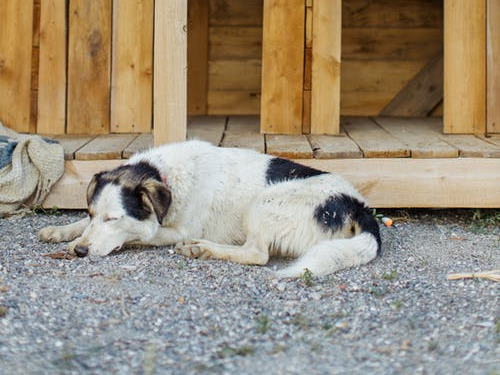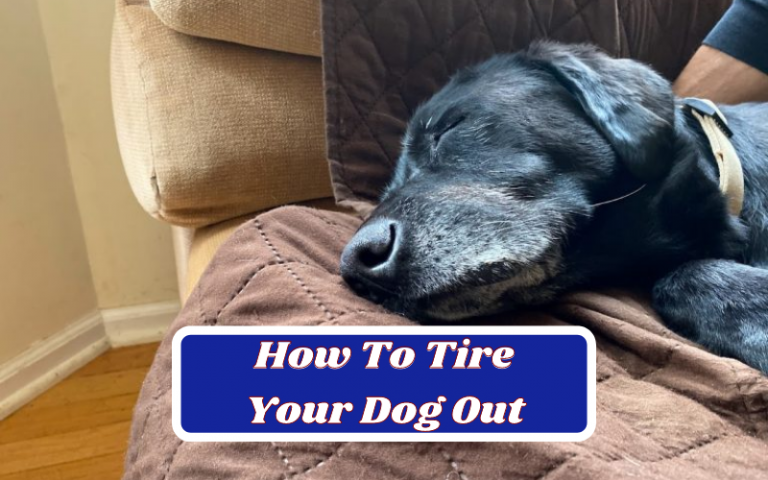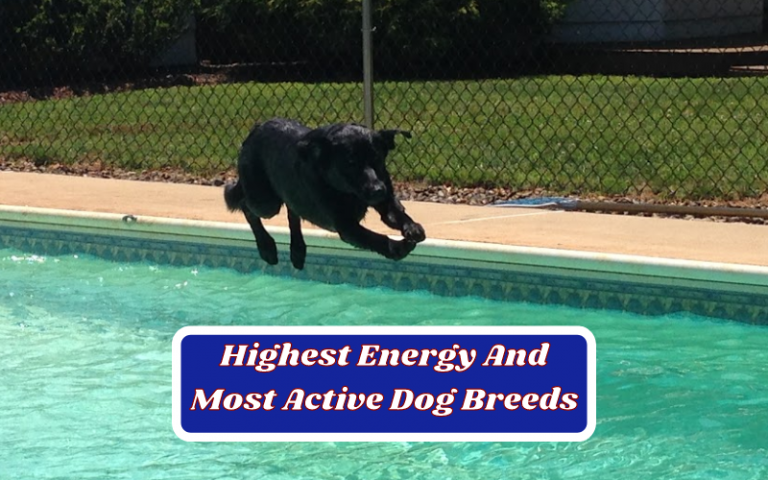The Real Reason Why Your Dog Is Wagging Their Tail In Their Sleep
* This post contains affiliate links, and we will be compensated if you buy after clicking on our links.

I’ll never forget the first time my Jack was wagging his tail in his sleep. I was sitting in my room and all of a sudden… I heard a loud BANG.
I then looked over at Jack and a couple seconds later again BANG!
He was wagging his tail while sleeping!
Now this can definitely leave you wondering and saying “what is happening”, “why are they doing this”, and “Is everything alright with my boy (or girl)?”
Well in this article we will be breaking down everything there is to know as to why your dog may be wagging their tail in their sleep, and even a few reasons as to why they may be doing this.
Ready to get started? Let’s Go!
Why You Dog Wags Their Tail In Their Sleep
Why Do Dogs Wag Their Tails In Their Sleep?
Dogs wag their tails while sleeping because they’re actually in a deep sleep. This is called REM (Rapid Eye Movement) and it occurs when your dog is in their deepest stages of sleep. During REM, your dog will dream just like us. Researchers have come to the conclusion that, like humans, dogs also experience dreaming during this deepest stage of sleep.
Often, during these stages, twitching, barking, and of course tail wagging are signs of dream-like behavior.
Most of us find dreams to be a unique mystery, and not even science can explain why most of our dreaming behaviors or things we do while we are asleep.
Dogs dream quite a bit while they sleep each night, just like humans do. They also engage in common behaviors while sleeping, such as tail wagging, in a manner similar to how we may walk or talk while asleep.
And a dog’s habit to wag his tail serves the same purpose whether he is awake or asleep, just like how we communicate with words or facial expressions.
Continue reading to find out what your dog’s sleeping patterns reveal about him and what he might be trying to tell you with his tail swing.
Is My Dog Dreaming?
The simple answer is, Yes. Because they are dreaming, dogs wag their tails while they are sleeping.
Dogs dream similarly to how we dream. Of course, it’s difficult to pinpoint the exact details of a dog’s dream.
When people wake up, they can talk about their dreams, but as you know, we can’t go and ask our dog what they dreamed about.
REM sleep is when dreams happen. In essence, during sleep, brain pathways become active, paralyzing the body to prevent movement. Because of this, when you run in your dreams, neither you nor your dog get out of bed and go for a run.
But the simple answer is something most likely happened in your dog’s dream causing them to wag their tail while they were sleeping.
Is My Dog Happy When They’re Wagging In Their Sleep

A dog is probably happy when it has a nice dream.
Naturally, a dog will wag its when it is happy. Only after your dog enters the REM cycle, can they wag while dreaming. Some examples of what may be happening are:
- A memory of the first time/last time they saw you.
- They are running after frisbee or tennis balls.
- They were just giving a big juicy treat
Another possibility for “sleep wagging” is that they are just content to sleep with you. However, we will discuss that later.
But Is It A Happy Dream?
In most cases, you can tell if a dog is having a happy dream that makes them feel good.
It involves more than just your dog wagging its tail while it sleeps. While sleeping, it may also carry out the following actions:
- Make small yips or barks when speaking.
- While they are still lying on their side, they appear to be running or jumping.
Do not be concerned if your dog’s tail is wagging or exhibits any other symptoms when you believe they’re dreaming happily.
What a Wagging Tail Says
Although being happy is one reason why dogs wag their tails, it is not the only one.
Due to their social nature, dogs must communicate just like people do. They have a wide range of other communication techniques they can use in place of words. The tail wag is one of them.
Your dog’s tail may be displaying a variety of emotions, such as fear, anxiety, guilt, or unadulterated joy, depending on its position, direction, and rate of swing.
When a dog is wagging his tail and simultaneously displaying other behaviors that are indicative of agitation or fear, it can be easy to mistake him for being friendly even though his body language says otherwise.
Fear Or Anxiety
Even if your dog’s tail is wagging, if he has his tail lowered and in between his legs, he probably isn’t feeling very comfortable.
Depending on the situation or other cues from his body language, such as pricked ears or tense positioning, he may be fearful or anxious.
A dog’s slow tail wag is typically not a sign of happiness. Instead, he might be conveying submission or fear. He might also be regretting ruining your favorite pair of slippers.
Try to reassure your dog and let him know he’s okay, even if he’s done something wrong, if you see a slow-moving tail.
Remember that if your tone is obviously one of anger or frustration, your dog will sense that and will react in kind by wagging his tail, whether it’s your favorite pair of shoes or the couch cushions that he’s chewed.
It’s important to remember that dogs simply act instinctively when they chew on your priceless possessions; they need to be taught the difference between their toys and yours.
Curiosity and attention
Your dog is probably curious or focused if his tail is standing up straighter than usual. He may be waiting for you toss the ball to him. He is alert and paying close attention as he plans his next move.
Some dogs are particularly skilled at recognizing objects or prey by pointing at them with their paws while also holding their tails up high, similar to how you might stand more upright when you are trying to listen intently or hear what someone is saying.
These “pointer” dogs may also engage in these behaviors while they are sleeping, particularly if they have been conditioned to do so while awake during the day.
Happy Dog
A wagging tail that swings vigorously typically indicates excitement or a friendly greeting.
Their tail moving swiftly back and forth from side to side indicates your dog is a happy boy (or girl). They might even begin circling in an effort to pursue it. All of these indicate that your dog is content and eager to see you.
Do Dog Breeds Or Age Affect How Dogs Dream?

Puppies dream more than adult dogs. This is due because the part of the brain stem (called the pons) is less active. This part of the brain is responsible for paralyzing large muscles during sleep, this also can prevent things like sleepwalking.
Size rather than breed is more likely to influence how dogs dream. Shorter and more frequent dreams are more common in small dogs. Larger dogs dream longer but less frequently than smaller dogs.
If you notice your dog having a nightmare, this can help put things in perspective for you. A small dog will leave the dream quickly. Dreams can last up to five minutes in large breeds.
Should You Wake a Sleeping Dog?

You might wonder if your dog is having nightmares if you see them sleeping with their tails tucked.
According to popular belief, dogs can experience both happy and unpleasant dreams. When they are having nightmares, some dogs will even whine while they are asleep.
This begs the question: Should you wake up a dog who is having nightmares?
For a number of reasons, it’s best to let sleeping dogs lie.
First, it’s safe.
You experience a brief loss of orientation when you are roused from a deep sleep. It might take some time for you to realize where you are.
Your dog is the same way. If you wake someone up from a nightmare, they might bite you before they realize that their dream is over.
The second is that REM sleep is crucial for the wellbeing of your dog. Sleep quality suffers overall when sleep cycles are disturbed. Your dog might have trouble falling asleep again and lose out on valuable time spent in deep, restful sleep.
If you do decide to wake them, remember, avoid yelling at them or speaking in a nervous tone of voice as this may frighten them even more.
Once your dog is awake, calm them down by giving them a treat or their favorite toy.
Having a Seizure
In rare cases, a dog’s tail wagging while it’s dozing can signal a seizure. Due to the fact that seizure movements can resemble sleep movements, this can be challenging to identify.
During a seizure, your dog’s body may become rigid or tight. It’s easy to feel anxious and fearful when you witness seizures because they are so frightening. Instead, try to maintain your composure because your dog will rely on you and may require your help.
If your dog is seizing and is lying in an elevated position, try to support the head with a soft towel. Prevent them from falling if they are high up..
When they are having a seizure, stay away from their mouths and don’t stick your hand in there. That might make your dog bite you, or you might end up choking your dog.
Dogs May Even Wag When They Are Cold

When dogs are cold, they might wag their tail while sleeping. It may look more like a twitch than a wag.
There will be more indications that your dog is cold than just a wagging tail. These symptoms can appear in both awake and sleeping dogs, and they are fairly typical for a dog that is cold.
- The dog will tremble and tremble.
- When they are sleeping, their teeth might whirr.
- They could be exhaling heavily.
- Tremors could also appear in the dog.
Make sure to warm up your dog if they are cold. It can work with your body heat, a blanket, or even a space heater.
Your Dog May Have Anxiety
Dogs do, in fact, wag their tails when they are anxious. But how do you know if anxiety is the root of the problem, and what can you do to fix it?
Do you know what makes dogs anxious, when you give it some thought? A few causes and signs exist, but let’s start with the causes.
- Due to their unfamiliar surroundings, dogs can experience anxiety. Your dog may experience anxiety if you are away from home or if you recently moved.
- Dog separation anxiety is a very common problem. Think about whether you’ll be away from your dog or if they’ll be spending the night at a kennel. That’s not only a strange place, but you’re separated from your dog as well.
- Abusive dogs are another big contributor to dogs having anzcity.
But you might be asking, how would I know if my dog has anxiety?
Well, we have a full article on anxiety here, but some signs to look for include:
- Excessive barking while they are sleeping, to the point of becoming hoarse.
- While dozing off, your dog unintentionally urinates or defecates on themselves.
- Drooling or panting while sleeping is another indication of anxiety.
Conclusion
Watching a sleeping dog’s tail go back and forth might release a variety of emotions, including excitement, fear, or happiness or contentment.
When dogs are sleeping, their tails may wag as if they are having a pleasant and exciting dream, or they may wag anxiously if they are having a nightmare.
As pet parents, all of these situations are fairly simple to handle.
You have two options: either gently wake your dog from the nightmare or allow them to have a good night’s sleep.
Even when your pet is sleeping, it is still advisable to keep an eye on their whereabouts to let them know you are there if they need anything.




